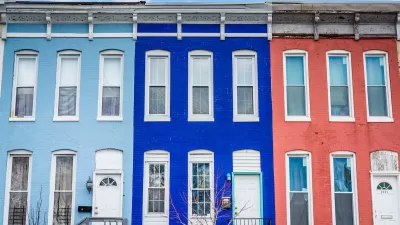Adam Davidson reflects on the urban decay that can be glimpsed out the window of an Amtrak train traveling between New York and Washington D.C., and the forces transforming the nation's economy that cannot.
Davidson and photojournalist Pieter Hugo use the to tell the story of America's changing economic, social, and physical landscape of "urban and industrial decay" as glimpsed from the seat of an Amtrak train bound for D.C. from New York. "[F]for most of
the 180 or so years of the train line's existence, the endpoints of this
journey - New York and D.C. - were subordinate to the roaring engines
of productivity in between," writes Davidson. "This model was flipped inside out as Wall Street and D.C. became central
drivers, not secondary supports, of the nation's economy."
In his essay, Davidson charts the loss of middle class manufacturing jobs, the decline of the communities built around that economy, and the rise of highly-specialized and service sector jobs.
"Manufacturing nostalgia is as powerful as ever. But one more look out
the Amtrak window reveals something else: the shiny new buildings that are
actually filled with workers have nothing to do with manufacturing.
They're in the broad service sector, in the anonymous office centers
that bloomed out of nowhere - near Metropark Station in New Jersey and
in Claymont, Del., and Aberdeen, Md. - to hold law firms and engineering
companies and I.T. firms. For people with advanced training, the
service sector means an above-average wage, a below-average risk of
unemployment and days sitting at a desk. For those with only a
high-school degree or no degree at all, far fewer jobs are available,
and the ones that are pay poorly and disappear quickly."
"Calling for a
return to the days when everybody who was willing to put in a hard day's
work could make a good living at the factory is a fantasy, maybe a lie
and certainly an implicit acknowledgment that nobody has any idea what
to do with the underemployed in the slums of Trenton, Philadelphia,
Baltimore and Southeast D.C. It's safer to talk about Pakistan."
Editor's Note: We've updated this post to include Diana Lind's commentary on Davidson's essay, which was published this morning:
"As someone who lives in Philadelphia but grew up in New York City, I found the Times'
position that the economies along the Amtrak corridor are nothing like
New York or D.C. as typical of New York provincialism," writes Lind. "I reject the
underlying thesis of the photo essay, which is that - according to the
view from Amtrak - cities like Philadelphia and Baltimore have wretched
economies, are poor and are radically different from New York or D.C...Where Davidson throws his hands up and wonders how places in the 'Empire
of the In-Between' will ever rebound, I'd like to propose a few
solutions that are specifically related to the condition of Amtrak and
what differentiates the cities along its corridor."
FULL STORY: Empire of the In-Between

Study: Maui’s Plan to Convert Vacation Rentals to Long-Term Housing Could Cause Nearly $1 Billion Economic Loss
The plan would reduce visitor accommodation by 25,% resulting in 1,900 jobs lost.

North Texas Transit Leaders Tout Benefits of TOD for Growing Region
At a summit focused on transit-oriented development, policymakers discussed how North Texas’ expanded light rail system can serve as a tool for economic growth.

Why Should We Subsidize Public Transportation?
Many public transit agencies face financial stress due to rising costs, declining fare revenue, and declining subsidies. Transit advocates must provide a strong business case for increasing public transit funding.

How to Make US Trains Faster
Changes to boarding platforms and a switch to electric trains could improve U.S. passenger rail service without the added cost of high-speed rail.

Columbia’s Revitalized ‘Loop’ Is a Hub for Local Entrepreneurs
A focus on small businesses is helping a commercial corridor in Columbia, Missouri thrive.

Invasive Insect Threatens Minnesota’s Ash Forests
The Emerald Ash Borer is a rapidly spreading invasive pest threatening Minnesota’s ash trees, and homeowners are encouraged to plant diverse replacement species, avoid moving ash firewood, and monitor for signs of infestation.
Urban Design for Planners 1: Software Tools
This six-course series explores essential urban design concepts using open source software and equips planners with the tools they need to participate fully in the urban design process.
Planning for Universal Design
Learn the tools for implementing Universal Design in planning regulations.
Ascent Environmental
Borough of Carlisle
Institute for Housing and Urban Development Studies (IHS)
City of Grandview
Harvard GSD Executive Education
Toledo-Lucas County Plan Commissions
Salt Lake City
NYU Wagner Graduate School of Public Service




























